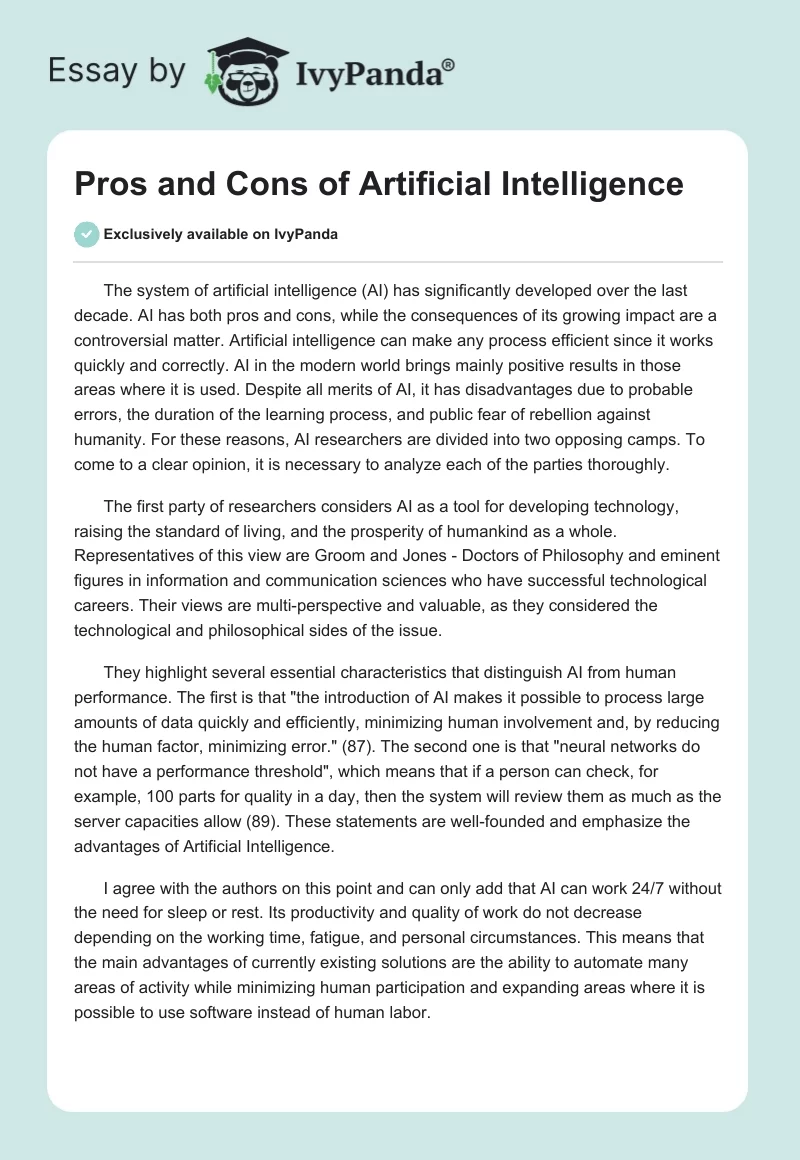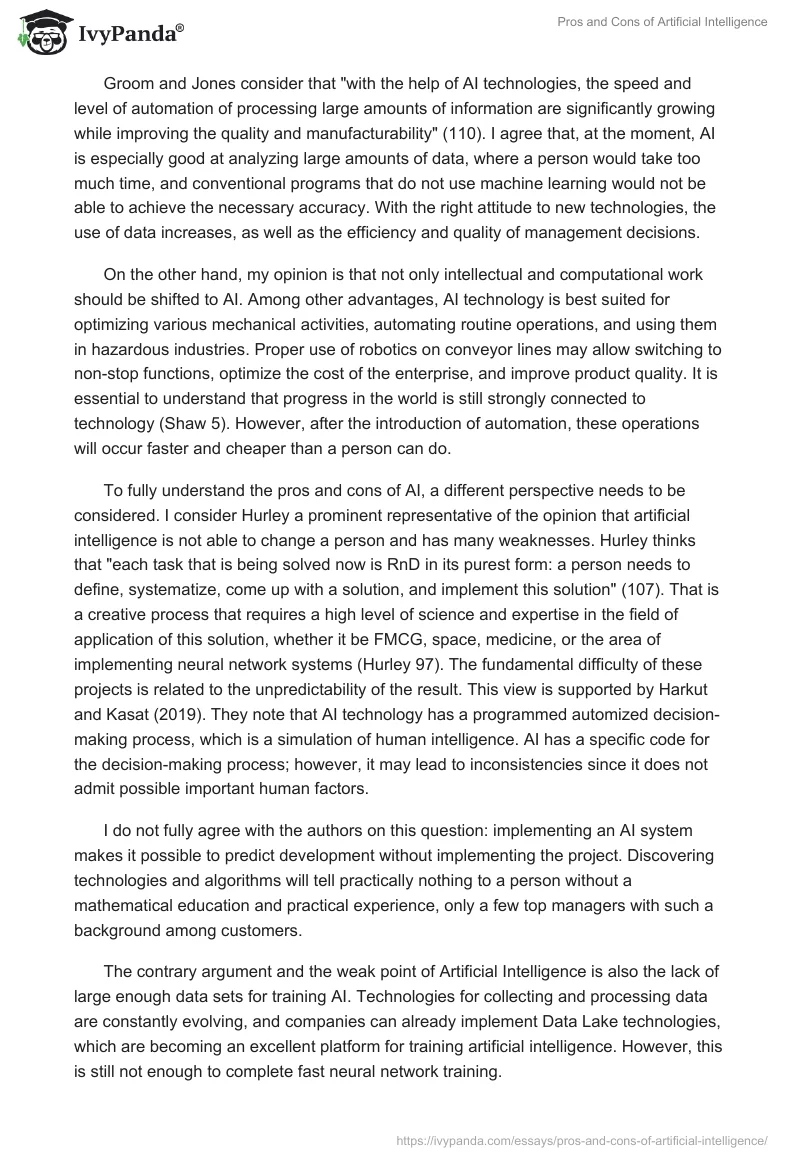The system of artificial intelligence (AI) has significantly developed over the last decade. AI has both pros and cons, while the consequences of its growing impact are a controversial matter. Artificial intelligence can make any process efficient since it works quickly and correctly. AI in the modern world brings mainly positive results in those areas where it is used. Despite all merits of AI, it has disadvantages due to probable errors, the duration of the learning process, and public fear of rebellion against humanity. For these reasons, AI researchers are divided into two opposing camps. To come to a clear opinion, it is necessary to analyze each of the parties thoroughly.
The first party of researchers considers AI as a tool for developing technology, raising the standard of living, and the prosperity of humankind as a whole. Representatives of this view are Groom and Jones – Doctors of Philosophy and eminent figures in information and communication sciences who have successful technological careers. Their views are multi-perspective and valuable, as they considered the technological and philosophical sides of the issue.
They highlight several essential characteristics that distinguish AI from human performance. The first is that “the introduction of AI makes it possible to process large amounts of data quickly and efficiently, minimizing human involvement and, by reducing the human factor, minimizing error.” (87). The second one is that “neural networks do not have a performance threshold”, which means that if a person can check, for example, 100 parts for quality in a day, then the system will review them as much as the server capacities allow (89). These statements are well-founded and emphasize the advantages of Artificial Intelligence.
I agree with the authors on this point and can only add that AI can work 24/7 without the need for sleep or rest. Its productivity and quality of work do not decrease depending on the working time, fatigue, and personal circumstances. This means that the main advantages of currently existing solutions are the ability to automate many areas of activity while minimizing human participation and expanding areas where it is possible to use software instead of human labor.
Groom and Jones consider that “with the help of AI technologies, the speed and level of automation of processing large amounts of information are significantly growing while improving the quality and manufacturability” (110). I agree that, at the moment, AI is especially good at analyzing large amounts of data, where a person would take too much time, and conventional programs that do not use machine learning would not be able to achieve the necessary accuracy. With the right attitude to new technologies, the use of data increases, as well as the efficiency and quality of management decisions.
On the other hand, my opinion is that not only intellectual and computational work should be shifted to AI. Among other advantages, AI technology is best suited for optimizing various mechanical activities, automating routine operations, and using them in hazardous industries. Proper use of robotics on conveyor lines may allow switching to non-stop functions, optimize the cost of the enterprise, and improve product quality. It is essential to understand that progress in the world is still strongly connected to technology (Shaw 5). However, after the introduction of automation, these operations will occur faster and cheaper than a person can do.
To fully understand the pros and cons of AI, a different perspective needs to be considered. I consider Hurley a prominent representative of the opinion that artificial intelligence is not able to change a person and has many weaknesses. Hurley thinks that “each task that is being solved now is RnD in its purest form: a person needs to define, systematize, come up with a solution, and implement this solution” (107). That is a creative process that requires a high level of science and expertise in the field of application of this solution, whether it be FMCG, space, medicine, or the area of implementing neural network systems (Hurley 97). The fundamental difficulty of these projects is related to the unpredictability of the result. This view is supported by Harkut and Kasat (2019). They note that AI technology has a programmed automized decision-making process, which is a simulation of human intelligence. AI has a specific code for the decision-making process; however, it may lead to inconsistencies since it does not admit possible important human factors.
I do not fully agree with the authors on this question: implementing an AI system makes it possible to predict development without implementing the project. Discovering technologies and algorithms will tell practically nothing to a person without a mathematical education and practical experience, only a few top managers with such a background among customers.
The contrary argument and the weak point of Artificial Intelligence is also the lack of large enough data sets for training AI. Technologies for collecting and processing data are constantly evolving, and companies can already implement Data Lake technologies, which are becoming an excellent platform for training artificial intelligence. However, this is still not enough to complete fast neural network training.
I consider it important to study the views on artificial intelligence by Dr. Garg. He is assistant director, of executive programs management at Amity University Uttar Pradesh India, a Ph.D. and UGC NET qualified with 15+ years of academic experience. As well as Dr. Agrawal is PhD, and UGC-NET qualified with 18+ years of experience in teaching and research, working as a Professor. Because of their significant experience and ability to evaluate using AI in real business processes, their opinion seems authoritative and worthy of attention. They consider that implementing artificial intelligence in business is a financially costly process (Agrawal and Garg 21). For industrial enterprises, such solutions may lead to a delayed economic effect.
Transitional solutions and real-time data visualization allow approximating economic benefits. Another difficulty is the need to restructure the business process when introducing intelligent systems (Agrawal and Garg 27). I consider it is not enough to buy such a solution and put it like a flower in a vase or an application on a computer. It is necessary to make this decision friendly to the business process: create, reconfigure, or even cancel some operations, retrain people, and optimize staff.
Most existing and developing artificial intelligence products aim to perform routine tasks by many specialists. Even though this leads to more straightforward work, it leads to a reduction in jobs. In Oshida’s opinion, it is unprofitable for the result to keep a certain number of professionals doing tasks under AI control (99). Accordingly, for the sake of the economy and profit, employers will seek to eliminate irrelevant employees (Faris et al. 61). Unemployment is increasing, and the retraining of specialists will take much time and additional resources of the state and the educational system. Further complicating the situation is that artificial intelligence does not make reason in human terms (Faris et al. 54). AI leads to the fact that the robot or computer does not take into account ethical norms and values. Its activity is designed to complete tasks but not to create a positive atmosphere, considering other people’s interests and teamwork.
Based on the totality of all the above points of view, I can conclude that artificial intelligence is an ambiguous technology for humanity. However, most of the problems that arise as a result of AI integration can be solved by indirect methods. For example, the number of vacancies for programmers and other professionals whose activities will be directed to the control and maintenance of computers will increase. From my point of view, that can retrain those dismissed due to lack of demand following the new standards, which will help keep the unemployment rate at the same level. At the same time, one should consider the large utility that AI provides for corporations and general human activities. I believe that this phenomenon has much more advantages than disadvantages, so abandoning artificial intelligence is inefficient.
Artificial intelligence is a somewhat controversial issue. The discussions around it are essential for its development. It is worth saying that artificial intelligence has two sides: positive and negative. Admittedly, the positive side is more significant, as it has enabled many industries to improve their operations and make them significantly more efficient. It is necessary to approach them non-standard to solve all the negative results of artificial intelligence.
Works Cited
Agrawal, Rashmi and Garg, Vikas. (Eds.). Transforming management using artificial intelligence techniques. CRC Press, 2020.
Faris, Hossam, Aljarah, Ibrahim, and Mirjalili, Seyedali. (Eds.). Evolutionary machine learning techniques. Algorithms and applications. Springer Singapore, 2017.
Groom, Frank M. and Jones, Stephan S. (Eds.). Artificial intelligence and machine learning for business for non-engineers. CRC Press, 2020.
Harkut, Dinesh G., and Kashmira Kasat. “Introductory chapter: artificial intelligence-challenges and applications.” Artificial Intelligence-Scope and Limitations (2019).
Hurley, Richard. Big data. Ationa Publishers, 2020.
Oshida, Yoshiki. Artificial intelligence for medicine. People, society, pharmaceuticals, and medical materials. De Gruyter, 2021.
Shaw, James, et al. “Artificial intelligence and the implementation challenge.” Journal of medical Internet research. Vol. 21, no. 7, 2019, p. 11.


